DIAMOND CUT QUIZ
This post contains affiliate links. If you use these links to buy something I may earn a commission. Thanks! As an Amazon Associate I also earn from qualifying purchases.
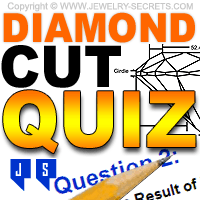
I love taking quizzes (I know, I’m a geek). But seriously, I just love learning.
And when we’re talking about diamonds, I love it even more.
So I’ve devised a clever little quiz to test you and your knowledge about this one particular 4C topic:
Diamond Cut
The cut of a diamond is by far, the most important aspect of a diamond. Yet sadly, it’s the hardest to understand and most jewelry stores don’t even touch on the subject. So in reality, learning is up to you.
I do a lot of talking about cut on my website here. I do my best to educate and inform anyone who wants to listen. And taking tests, exams, and quizzes is one of the best ways to grasp the full meanings and concepts of this difficult subject.
So let’s begin.
This quiz has 50 questions. Some are multiple choice, some true and false, others are fill-ins. All you have to do is to grab a pencil, a sheet of paper, and jot your answers down. You’ll be able to grade them at the end and see how you did. The answers follow the quiz (no fair peeking ahead), and then I’ll discuss the answers so you understand why.
Here we go…
I present to you, the diamond cut quiz.
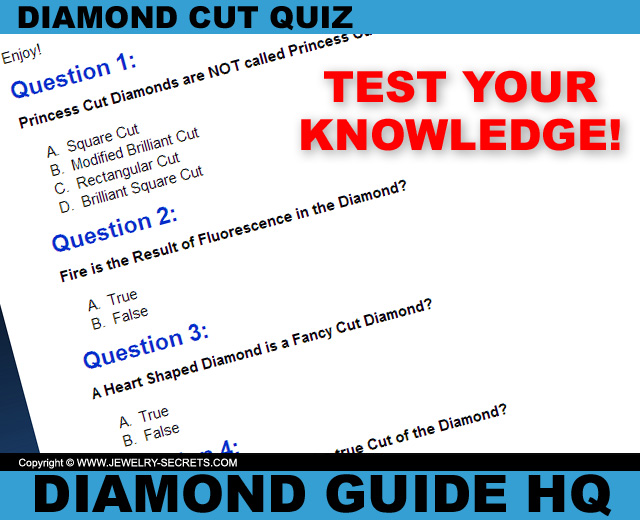
Enjoy.
Question 1:
Princess cut diamonds are not called princess cuts on a diamond report. They are called what?
- Square Cut
- Modified Brilliant Cut
- Rectangular Cut
- Brilliant Square Cut
Question 2:
Fire is the result of fluorescence in the diamond?
- True
- False
Question 3:
A heart shaped diamond is a fancy cut diamond?
- True
- False
Question 4:
The shape of a diamond is the true cut of the diamond?
- True
- False
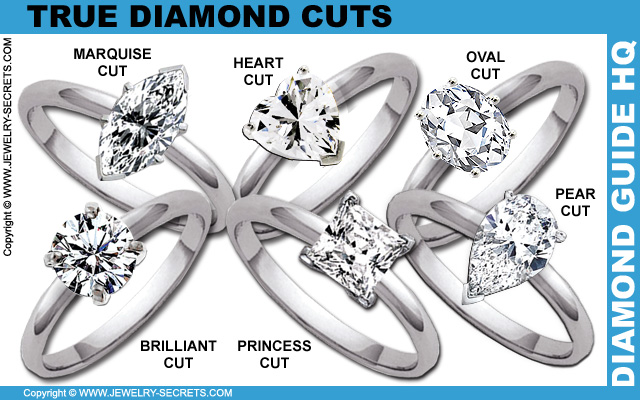
Question 5:
Pick the cut of diamond that’s round in shape:
- Ariella Cut
- Crown Of Light Cut
- Dutch Rose Cut
- Flame Cut
Question 6:
The polish of the stone has no impact on how the stone is cut?
- True
- False
Question 7:
The more facets a diamond has, the more it will sparkle?
- True
- False
Question 8:
How many facets are there on a brilliant cut diamond?
- 60
- 59
- 58
- 57
Question 9:
The table of a round diamond is what shape?
- Octagon
- Square
- Star
- Round
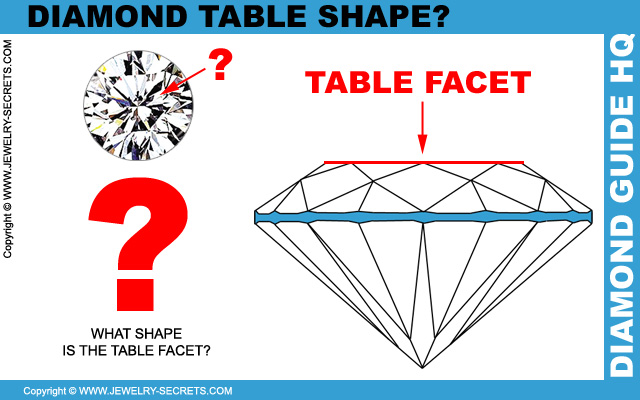
Question 10:
A single cut diamond has how many facets?
- 1
- 10
- 12
- 17
Question 11:
What’s the #1 reason why all diamonds aren’t cut ideal?
- Color
- Shape
- Clarity
- Profit
Question 12:
The hearts and arrows pattern refers to:
- Hearts on the Top, Arrows on the Bottom
- Hearts in the Center, Arrows on the Outside
- Arrows on the Top, Hearts on the Bottom
- Arrows in the Center, Hearts on the Outside
Question 13:
What makes a diamond a true hearts and arrows cut?
- High Clarity, High Color, High Cut
- Excellent Cut, No Fluorescence
- Ideal Cut and Polish
- Triple Excellent Cut
Question 14:
What part of the diamond is considered 100%?
- Diameter
- Crown
- Table
- Depth
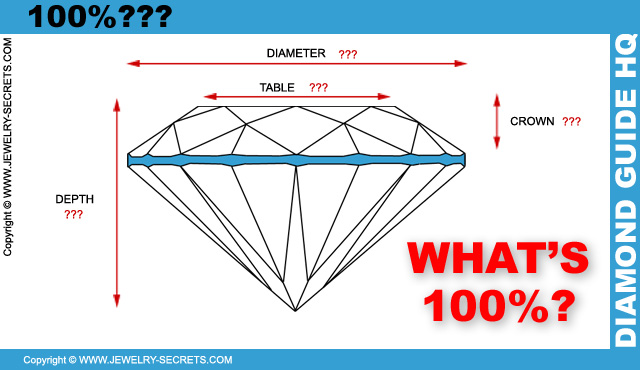
Question 15:
The diamond plot on a GIA diamond report is actually called the “profile to actual proportions”?
- True
- False
Question 16:
The new GIA cut grade looks at how many different facet criteria?
- 3
- 7
- 10
- 16
Question 17:
What part of the cut has hills and valleys?
- Girdle
- Culet
- Pavilion
- Star Facets
Question 18:
“No Culet” is not the same thing as “none” for a culet grade?
- True
- False
Question 19:
Symmetry means:
- The Diamond weighs the same on both the Top and the Bottom of the Girdle
- The Facets are Polished with a Mirror Finish
- The Diamond has Extra Fire around the Table Facets
- All the Different Facets are the Exact Same Shape and Size
Question 20:
How many GIA cut grades are there?
- 4
- 5
- 6
- 7
Question 21:
An excellent cut grade can have a medium sized culet?
- True
- False
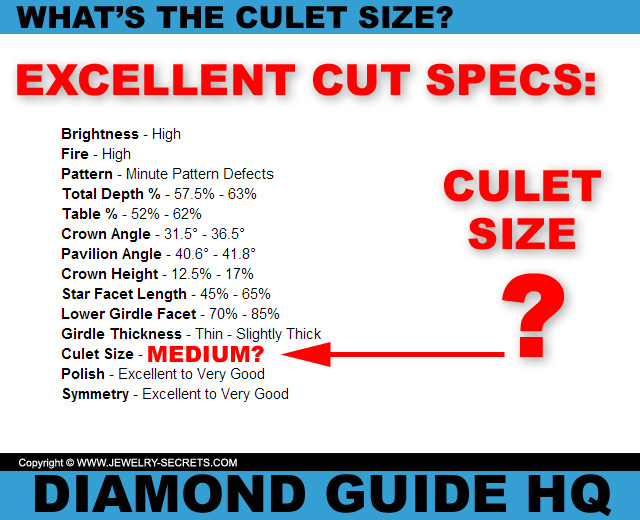
Question 22:
If your girdle thickness is “very thick”, it can still be a good cut?
- True
- False
Question 23:
If a diamond is cut too deep, it can resemble a:
- Flat Tire
- Nail Head
- Fish Eye
- Bullet Hole
Question 24:
What diamond cut gives you the most brilliance?
- Princess Cut
- Brilliant Cut
- Cushion Cut
- Radiant Cut

Question 25:
If a girdle is faceted, those facets don’t add towards the facet count of the entire diamond?
- True
- False
Question 26:
The bezel facet is actually what shape?
- Kite
- Triangle
- Pie
- Bezel
Question 27:
Shallow diamonds don’t leak light, they actually brighten and whiten the stone?
- True
- False
Question 28:
What’s the name of the man who devised the ideal cut diamond?
________________________________
Question 29:
Crown angles and pavilion angles should always be the same percentage?
- True
- False

Question 30:
You can tell a lot about the way a diamond is cut simply by looking at the table?
- True
- False
Question 31:
What’s dispersion in a diamond?
- Fire
- Brilliance
- Sparkle
- Scintillation
Question 32:
A larger table will give you more white light, or more color light in the diamond?
- More White Light
- More Color Light
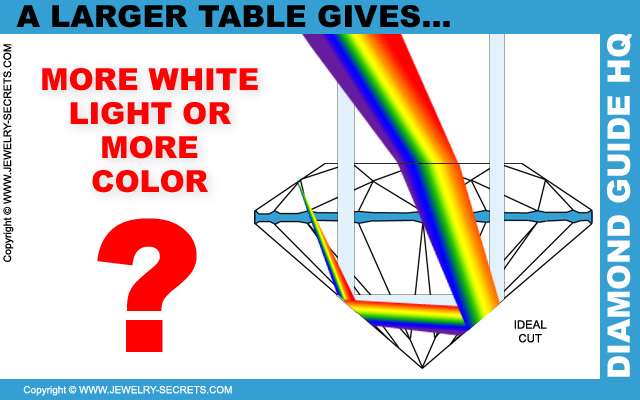
Question 33:
An ideal diamond depth is what percentage range?
- 58.7-62.3%
- 55.2-65.3%
- 60-60%
- 58.1-69.2%
Question 34:
The most expensive cut of diamond is what shape?
- Square
- Round
- Trillion
- Baguette
Question 35:
There are no true “ideal cut standards” for other cuts of diamond except for the round brilliant cut?
- True
- False
Question 36:
The cut of a stone can determine if a diamond looks larger in appearance or not?
- True
- False
Question 37:
Most round diamonds are not perfectly round?
- True
- False
Question 38:
What can make a diamond appear to have a hole in the center of it?
- Star Facet Reflections
- A Very Thick Girdle
- A Large Culet
- Extra Pavilion Facets
Question 39:
Emerald cuts have extra facets on them that add sparkle and help mask flaws and inclusions?
- True
- False
Question 40:
What’s the best diamond girdle to buy?
- Very Thin, Thin, Thick
- Thin, Medium, Thick
- Thin, Medium, Slightly Thick
- Very Thin, Medium, Thick
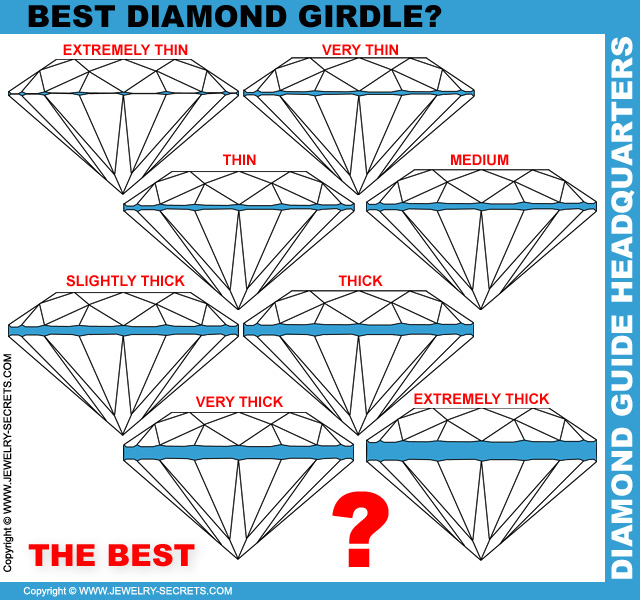
Question 41:
Once a diamond is chipped or cracked, there isn’t anything you can do with it?
- True
- False
Question 42:
Baguette cut diamonds have how many facets?
- 8
- 10
- 13
- 16
Question 43:
What’s the weakest part of the diamond?
________________________________
Question 44:
What cut of diamond came directly before the brilliant cut?
- European Cut
- Table Cut
- Point Cut
- Mazarin Cut
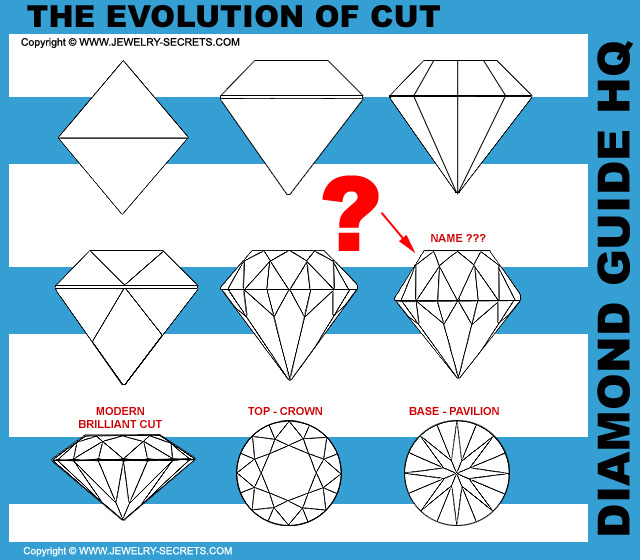
Question 45:
For an ideal cut, 1.00 carat diamond, what should the millimeter size be?
- 6.5 mm
- 6.6 mm
- 6.8 mm
- 7.0 mm
Question 46:
A princess cut diamond is square in shape?
- True
- False
Question 47:
If your diamond is ideal cut, VVS1 clarity, E color, it can still look bad. Why?
- No Culet
- Rough Girdle
- Naturals
- Fluorescence
Question 48:
What’s the second most popular cut of diamond?
- Marquise
- Radiant
- Princess
- Cushion
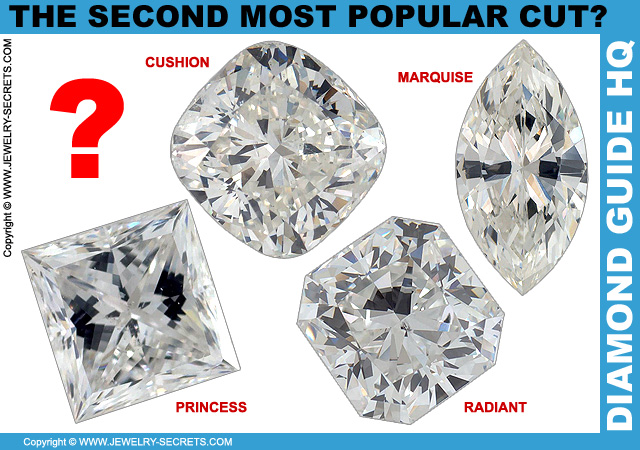
Question 49:
What cut of diamond is the Hope diamond?
- Crown of Light
- Cushion
- Brilliant
- Ariella
Question 50:
What does a bad cut do to the diamond?
- Makes the Diamond Cheaper
- Makes the Diamond Sparkle Less
- Makes the Diamond look Bigger
- Makes the Diamond Dark
So How Did you Do?
Now that you’ve gone through all 50 questions, it’s time to get into the answers.
I’ll highlight the correct answers, and then discuss them after the question, just so you understand where I’m coming from.
Here we go…
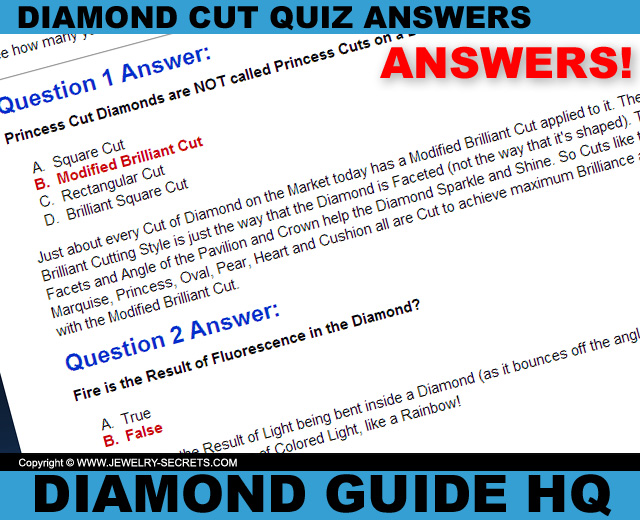
The Answers:
See how many you got right… :)
Question 1 Answer:
Princess cut diamonds are not called princess cuts on a diamond report. They are called what?
- Square Cut
- Modified Brilliant Cut
- Rectangular Cut
- Brilliant Square Cut
Just about every cut of diamond on the market today has a modified brilliant cut applied to it. The brilliant cutting style is just the way that the diamond is faceted (not the way that it’s shaped). The facets and angle of the pavilion and crown help the diamond sparkle and shine. So cuts like the marquise, princess, oval, pear, heart and cushion all are cut to achieve maximum brilliance and fire with the modified brilliant cut.
Question 2 Answer:
Fire is the result of fluorescence in the diamond?
- True
- False
Nope! Fire is the result of light being bent inside a diamond (as it bounces off the angles) and coming back out in rays of color light; like a rainbow.
Question 3 Answer:
A heart shaped diamond is a fancy cut diamond?
- True
- False
True! In fact, every single cut of diamond other than the round brilliant cut diamond is called a fancy cut.
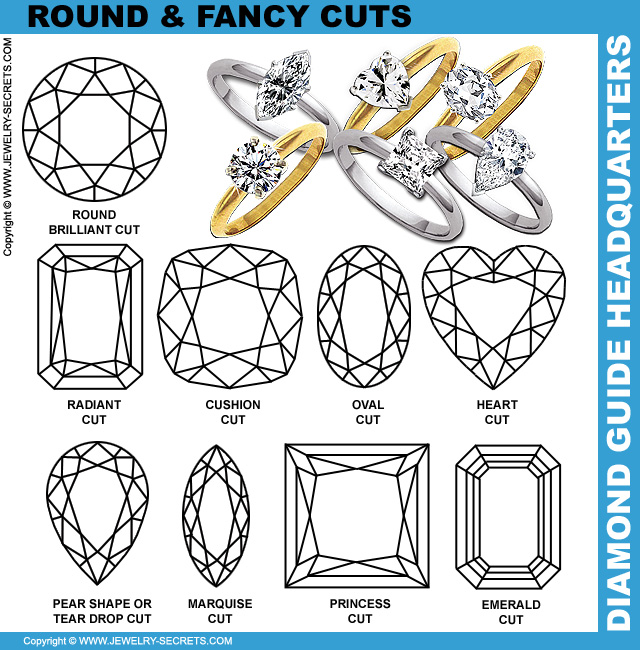
Question 4 Answer:
The shape of a diamond is the true cut of the diamond?
- True
- False
Nope! The shape is just the shape. The cut is more about the proportions, percentages, angles, symmetry, and the faceting of the diamond.
Question 5 Answer:
Pick the cut of diamond that’s round in shape:
- Ariella Cut
- Crown Of Light Cut
- Dutch Rose Cut
- Flame Cut
Tricky… These cuts of diamond are all Round in shape.
Question 6 Answer:
The polish of the stone has no impact on how the stone is cut?
- True
- False
False! Cut is a combination of the cutting style, symmetry, and polish.
Question 7 Answer:
The more facets a diamond has, the more it will sparkle?
- True
- False
False claim! Some jewelers want you to believe that you’ll get more sparkle out of a diamond that has more facets, but it’s entirely untrue. You may get more flashes of light, but those flashes will be smaller than usual, and they don’t really amount to any more sparkle. Just smaller sparkles.
Question 8 Answer:
How many facets are there on a brilliant cut diamond?
- 60
- 59
- 58
- 57
I’ll take both C and D for this answer, because a brilliant cut diamond could have 57 if it has no culet (which means that it comes to a point at the pavilion), or it could have 58 facets if it does have a culet (octagon facet at the base of the diamond). Both could be correct depending on the actual diamond you look at.
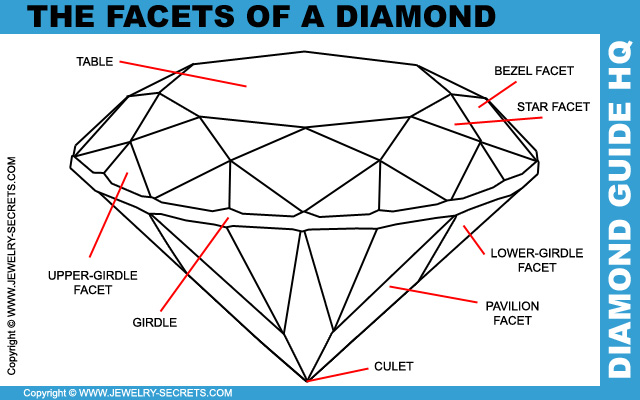
Question 9 Answer:
The table of a round diamond is what shape?
- Octagon
- Square
- Star
- Round
Octagon (see image above). Hold the diamond at an angle and see the reflection bounce off the top surface. You’ll see that it’s octagon in shape.
Question 10 Answer:
A single cut diamond has how many facets?
- 1
- 10
- 12
- 17
Single cuts, also called melee (and sometimes also called accent stones), have a total of 17 or 18 facets (depending if it has a culet or not).
Question 11 Answer:
What’s the #1 reason why all diamonds aren’t cut ideal?
- Color
- Shape
- Clarity
- Profit
It’s all about money. That’s the bottom line for everything in life. Diamond cutters look at the parent rock and make a decision on how it’s going to be cut solely based upon the maximum way to make the most profit from the stone. If one stone ends up narrow and shallow, but another one ends up ideal, then so be it. See below for an example…
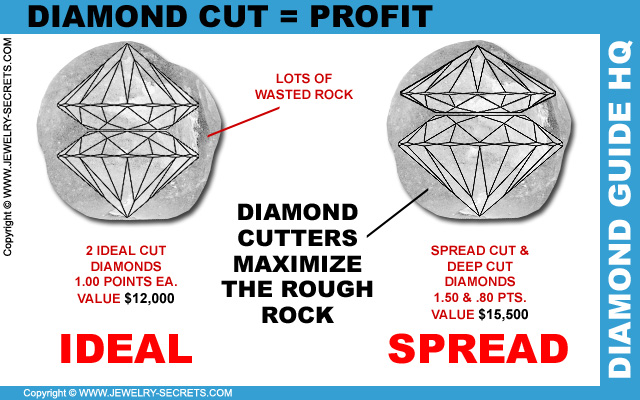
Question 12 Answer:
The hearts and arrows pattern refers to:
- Hearts on the Top, Arrows on the Bottom
- Hearts in the Center, Arrows on the Outside
- Arrows on the Top, Hearts on the Bottom
- Arrows in the Center, Hearts on the Outside
Hearts and arrows, as seen in this photo here:
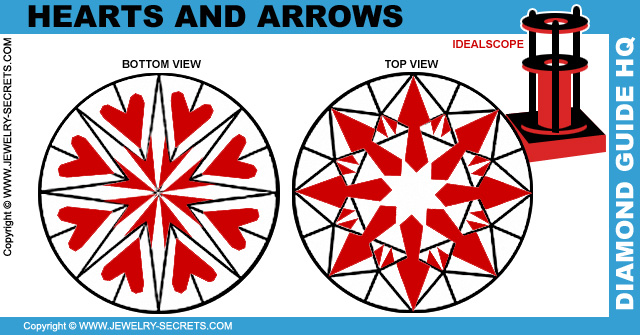
Question 13 Answer:
What makes a diamond a true hearts and arrows cut?
- High Clarity, High Color, High Cut
- Excellent Cut, No Fluorescence
- Ideal Cut and Polish
- Triple Excellent Cut
To be a true hearts and arrows cut, it really is just about cut and not about color, clarity or carat weight. And to achieve those hearts and arrows pattern, you’ll need to not only have an excellent cut, but an excellent polish and excellent symmetry as well. That’s triple excellent.
Question 14 Answer:
What part of the diamond is considered 100%?
- Diameter
- Crown
- Table
- Depth
The diameter of the stone is always 100%. The diameter is the measurement from one side of the girdle to the direct opposite side. Every thing else measured on the diamond (like the depth and the crown height) is measured against that 100% mark. So a table that’s 60% means that the table is 60% of the width of the widest part of the diamond; the diameter.
Question 15 Answer:
The diamond plot on a GIA diamond report is actually called the “profile to actual proportions”?
- True
- False
False! The diamond plot is the diamond plot, or technically called the “reference diagram” (as shown below). The “profile to actual proportions” (image also coming up below) shows you the cut profile and the percentages and angles of that particular stone.
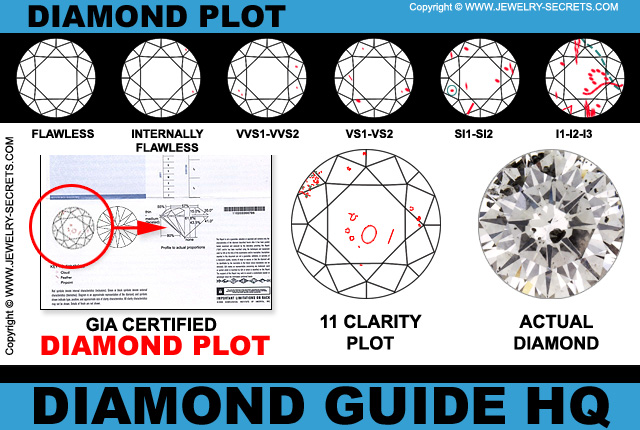
Question 16 Answer:
The new GIA cut grade looks at how many different facet criteria?
- 3
- 7
- 10
- 16
There are 10 things that GIA looks at to determine the overall proportions of the diamond. They are: girdle thickness, star length, table size, total depth, crown height, pavilion depth, crown angle, pavilion angle, lower girdle facet length, and culet size. As shown here:
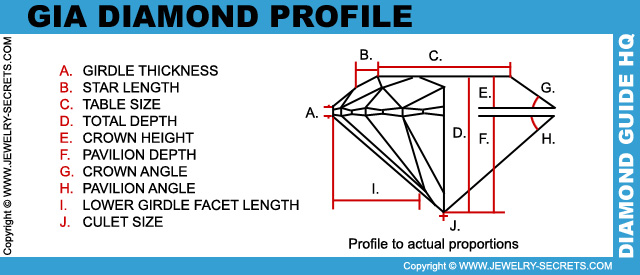
Question 17 Answer:
What part of the cut has hills and valleys?
- Girdle
- Culet
- Pavilion
- Star Facets
The girdle has hills and valleys that form as the facets on the top and bottom of the diamond meet. See them here:
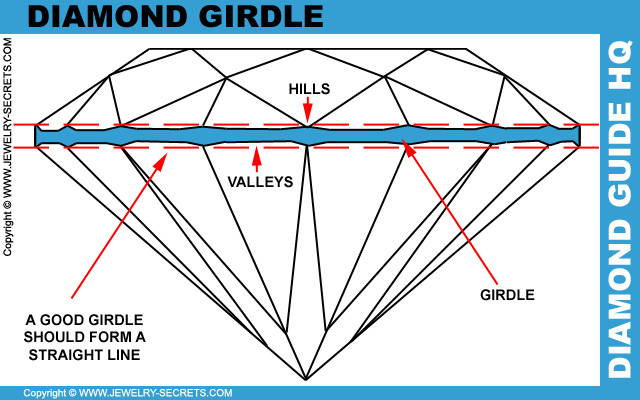
Question 18 Answer:
“No culet” is not the same thing as “none” for a culet grade?
- True
- False
Nope! They are the same thing. No culet is actually graded as “none” on a GIA diamond report.
Question 19 Answer:
Symmetry means:
- The Diamond weighs the same on both the Top and the Bottom of the Girdle
- The Facets are Polished with a Mirror Finish
- The Diamond has Extra Fire around the Table Facets
- All the Different Facets are the Exact Same Shape and Size
Symmetry is how symmetrical the facets are. How each star facet is the exact same size and shape as every other star facet. The same with the pavilion facets and even the girdle. They should be similar, consistent and even. The table should be octagon and not out of shape. Everything is taken into consideration when determining the actual symmetry of the diamond. The better the symmetry, the more the diamond will sparkle and shine. :) See image below…
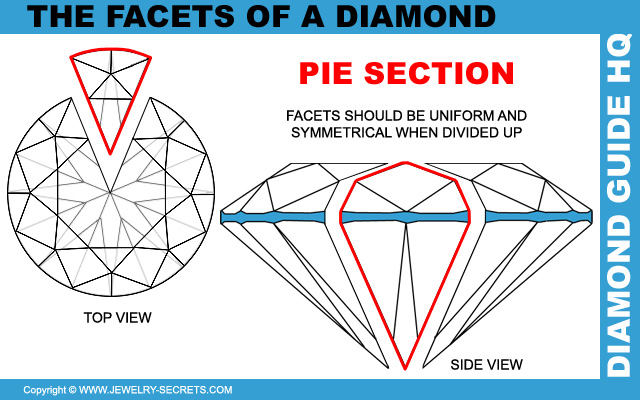
Question 20 Answer:
How many GIA cut grades are there?
- 4
- 5
- 6
- 7
There are 5 cut grades in all. They are: excellent, very good, good, fair and poor. Read more about cut grades here.
Question 21 Answer:
An excellent cut grade can have a medium sized culet?
- True
- False
False! To get the grade of “excellent”, a culet must be listed as either “none” or “small”. Read more about diamond culets here.
Question 22 Answer:
If your girdle thickness is “very thick”, it can still be a good cut?
- True
- False
Yes! A girdle can get the grades anywhere from “extremely thin to very thick” when grading a diamond as “good”. Read more about diamond girdles here.
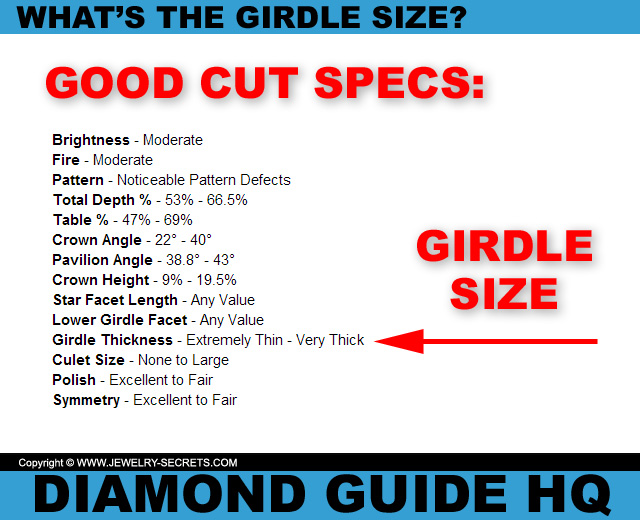
Question 23 Answer:
If a diamond is cut too deep, it can resemble a:
- Flat Tire
- Nail Head
- Fish Eye
- Bullet Hole
So true! When a diamond gets too deep, light is lost out the side and can’t illuminate the center of the stone. It tends to get dark and shadowy, which then resembles a nail head. See below for examples of both a nail head and the lovely fish eye.
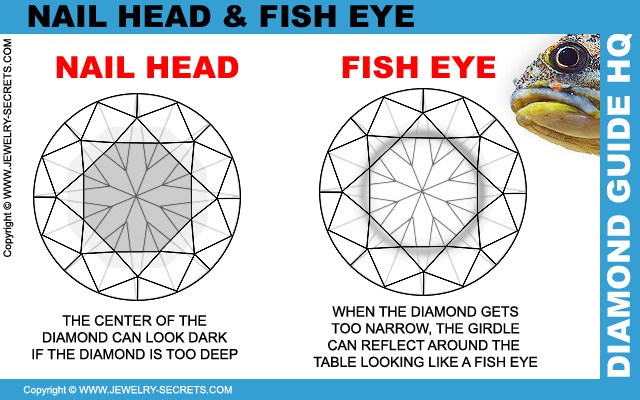
Question 24 Answer:
What diamond cut gives you the most brilliance?
- Princess Cut
- Brilliant Cut
- Cushion Cut
- Radiant Cut
The brilliant cut. That’s why it’s called the brilliant cut diamond. It gives you the maximum amount of light return, brilliance and sparkle. :)
Question 25 Answer:
If a girdle is faceted, those facets don’t add towards the facet count of the entire diamond?
- True
- False
This is true. Even if the facet of your diamond has 20 more facets going all the way around, it doesn’t change the actual facet count of the stone. It will still have 58 facets (or 57 with no culet).
Question 26 Answer:
The bezel facet is actually what shape?
- Kite
- Triangle
- Pie
- Bezel
The bezel facets look like a kite. Take a peek here:
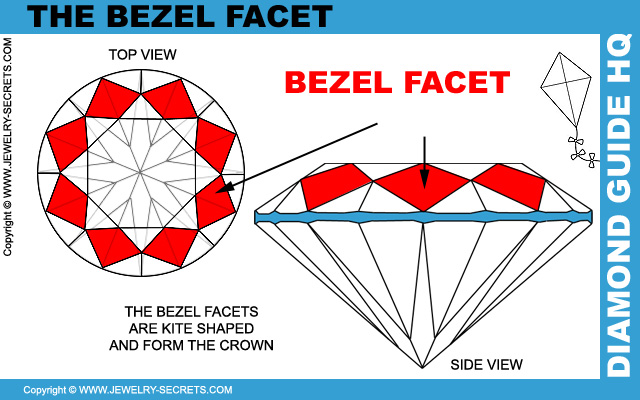
Question 27 Answer:
Shallow diamonds don’t leak Light, they actually brighten and whiten the stone?
- True
- False
False! The diamonds may be thin, but then all the light is leaked out of the bottom of the stone. It doesn’t get bounced back for the eye to enjoy. :(
Question 28 Answer:
What’s the name of the man who devised the ideal cut diamond?
Marcel Tolkowsky
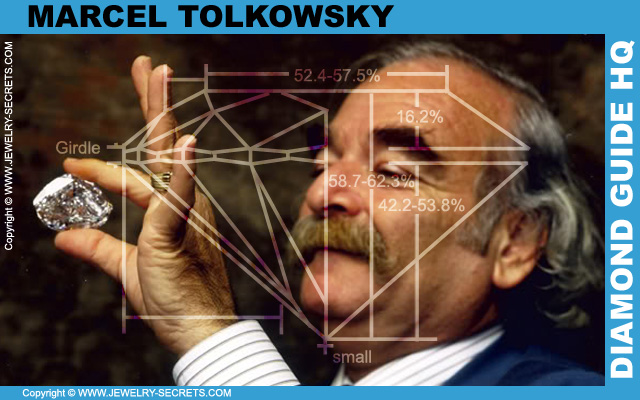
Question 29 Answer:
Crown angles and pavilion angles should always be the same percentage?
- True
- False
False! Ideal crown angle percentages are: 33.7-35.8%, and Ideal pavilion angle percentages are: 40.15-41.2%
Question 30 Answer:
You can tell a lot about the way a diamond is cut simply by looking at the table?
- True
- False
So very true! The table could be out of shape, skewed, angled, uneven… Reflected in the pavilion… The table can be a dead give-a-way as to how a diamond is cut. Learn more: the table of the diamond.
Question 31 Answer:
What’s dispersion in a diamond?
- Fire
- Brilliance
- Sparkle
- Scintillation
Dispersion is fire (which is color light). Brilliance is white light. Scintillation is the sparkle effects, and sparkle is well, everything including reflections. :)
Question 32 Answer:
A larger table will give you more white light, or more color light in the diamond?
- More White Light
- More Color Light
With a bigger table, it’s easier for light to come in and reflect back out giving you more white light. When the table is smaller, the crown angles become Larger, and the diamond will have more fire in the stone because the light gets bent. :)
Question 33 Answer:
An ideal diamond depth is what percentage range?
- 58.7-62.3%
- 55.2-65.3%
- 60-60%
- 58.1-69.2%
By Tolkowsky standards the ideal diamond depth (which is the crown and pavilion added together) is 58.7-62.3%
Question 34 Answer:
The most expensive cut of diamond is what shape?
- Square
- Round
- Trillion
- Baguette
The round, or brilliant cut diamond, is the most expensive cut of diamond there is. And that’s just because it’s the most popular shape, so demand hikes the price up. So buy a fancy cut and save some money. :)
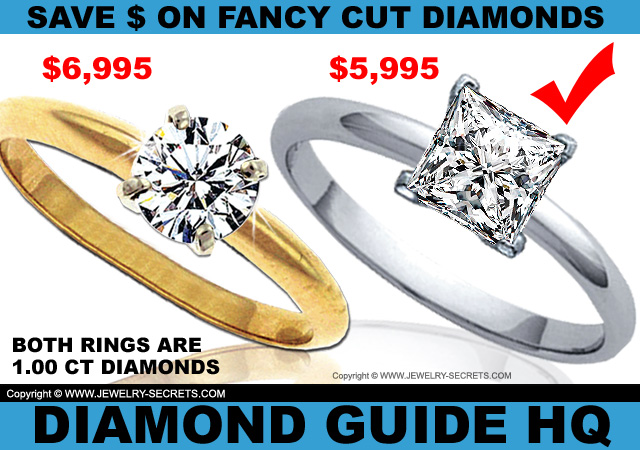
Question 35 Answer:
There are no true “ideal cut standards” for other cuts of diamond except for the round brilliant cut?
- True
- False
This is True! There are some criteria that they go by of course, but nothing really written in stone. I did an entire article about the ideal princess cut diamond here. It’s a very interesting read. :)
Question 36 Answer:
The cut of a stone can determine if a diamond looks larger in appearance or not?
- True
- False
True! If a diamond is cut narrow or thin, the width of the stone can be huge. Which means, it could look much bigger than it really is. These diamonds are called “spread” diamonds are are not preferred since they lose light, sparkle less, and can even become weak, brittle or chip easily. Buyer beware. Read: What are spread stones?
Question 37 Answer:
Most round diamonds are not perfectly round?
- True
- False
Very True! Just look at any diamond report and view the measurements of a round stone. You’ll see things like: 6.50 x 6.48 x 4.02. Which means that measuring one section of the stone (round stone) from girdle to girdle will give you 6.50 mm, but if you measure it from a different position you’ll get 6.48 mm. That’s not perfectly round. Almost no diamonds are perfect in shape or symmetry to get such exact measurements (that last measurement 4.02 is the mm depth of the stone). See diagram below for this example:
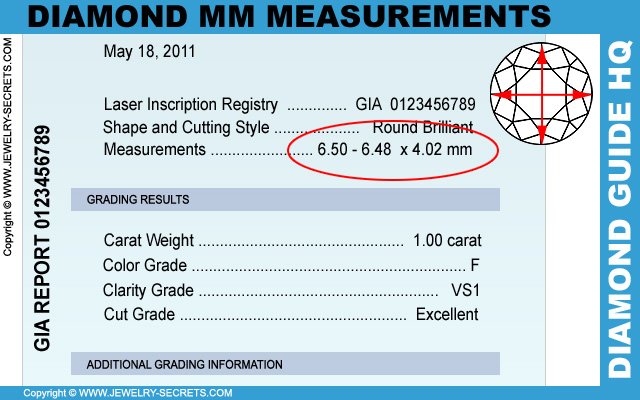
Question 38 Answer:
What can make a diamond appear to have a hole in the center of it?
- Star Facet Reflections
- A Very Thick Girdle
- A Large Culet
- Extra Pavilion Facets
The larger the culet is (large, very large or extremely large), the more the diamond will look like it has a hole in it, or as they say, a bullet hole. See the images below to understand…
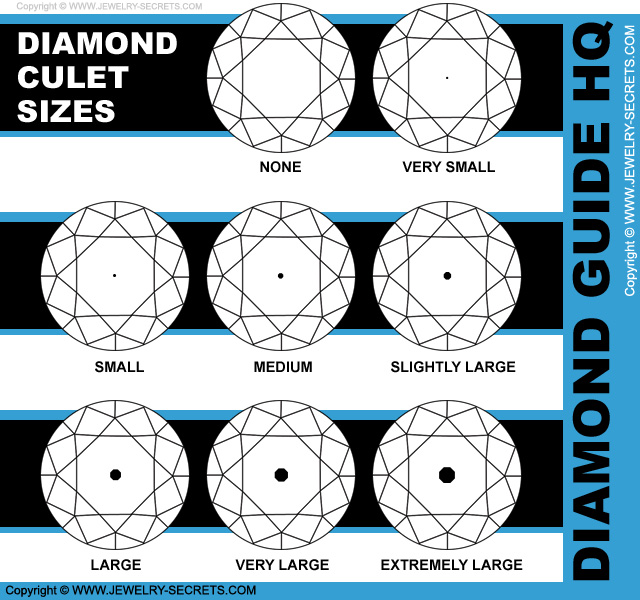
Question 39 Answer:
Emerald cuts have extra facets on them that add sparkle and help mask flaws and inclusions?
- True
- False
False! Just the opposite. Emerald cuts are by far the worst cut to have if you have a lower clarity diamond (like SI or I). That’s because they have less facets and less sparkle than most cuts of diamond, so the inclusions and flaws stand out and are way more obvious to the bare eye. If you want to buy an emerald cut diamond, you should opt for a clarity of at least VS2 or greater. That way you won’t be seeing flaws for the rest of your life. :)
Question 40 Answer:
What’s the best diamond girdle to buy?
- Very Thin, Thin, Thick
- Thin, Medium, Thick
- Thin, Medium, Slightly Thick
- Very Thin, Medium, Thick
The best girdle is either a thin, medium or slightly thick girdle grade. I prefer a thin or a medium girdle since they don’t stand out, won’t chip easily, and help protect the stone.
Question 41 Answer:
Once a diamond is chipped or cracked, there isn’t anything you can do with it?
- True
- False
False! You can sell chipped diamonds, or you can even send them out to have them re-cut, re-polished and re-faceted again. Read more about them here: cutting chipped diamonds.
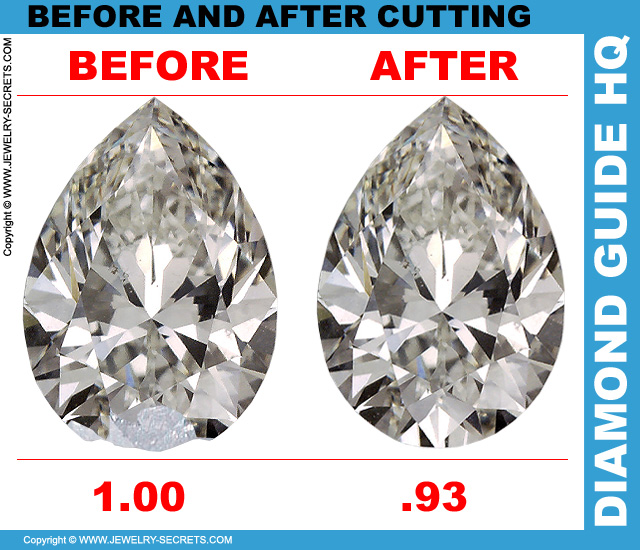
Question 42 Answer:
Baguette cut diamonds have how many facets?
- 8
- 10
- 13
- 16
Baguette cut diamonds look like little sticks. They don’t have very many facets on them, 13 in all, just enough to add some sparkle and beauty to your ring.
Question 43 Answer:
What’s the weakest part of the diamond?
Where it comes to a Point, like the Girdle, Culet or Tips!
The weakest part of any diamond is where it comes to a point. Like where the top and bottom of the diamond come together at the girdle. That’s the #1 spot to chip on a diamond since it takes the most abuse. But the culet can also be chipped, especially during setting, and the tips of any diamond, like the points on a marquise, princess or triangular shaped diamond are often vulnerable as well. Protecting those tips with v-tipped prongs is highly recommended. :)
Question 44 Answer:
What cut of diamond came directly before the brilliant cut?
- European Cut
- Table Cut
- Point Cut
- Mazarin Cut
The cut of diamond that lead into the brilliant cut diamond is called the European cut diamond. Before that was the old mine cut. :)
Question 45 Answer:
For an ideal cut, 1.00 carat diamond, what should the millimeter size be?
- 6.5 mm
- 6.6 mm
- 6.8 mm
- 7.0 mm
6.5 is the millimeter to achieve if you want the ideal width for a 1 carat diamond. See all the millimeter sizes for carat weights here.
Question 46 Answer:
A princess cut diamond is square in shape?
- True
- False
A princess cut diamond could really be square or rectangular in shape, or somewhere in between. Most people think of them as square, but most are almost never perfectly square, and most border more on rectangular in design. See the different shapes and ratios below…
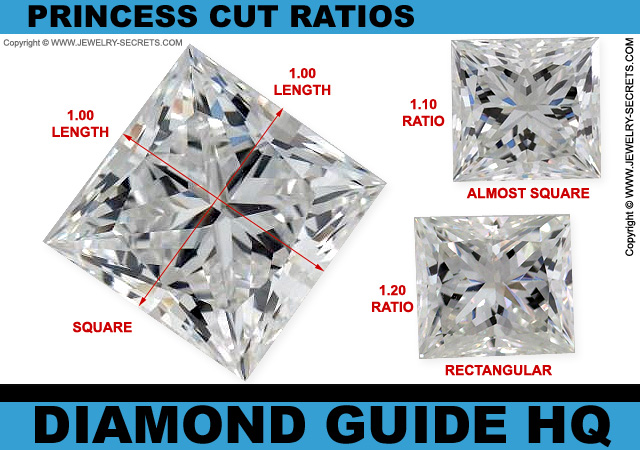
Question 47 Answer:
If your diamond is ideal cut, VVS1 clarity, E color, it can still look bad. Why?
- No Culet
- Rough Girdle
- Naturals
- Fluorescence
Fluorescence, especially if it’s strong fluorescence, can make any diamond appear bad, no matter what the cut, clarity, color or carat weight is. Every diamond is different and will face up different. It’s wise to view the diamond before you buy it, just to be sure. Read more about fluorescence here.
Question 48 Answer:
What’s the second most popular cut of diamond?
- Marquise
- Radiant
- Princess
- Cushion
Princess cut diamonds are #2 on the most popular diamond engagement ring list. They look big, they sparkle greatly, and the deals are hot. :)
Question 49 Answer:
What cut of diamond is the Hope diamond?
- Crown of Light
- Cushion
- Brilliant
- Ariella
The Hope diamond, the most famous diamond in the World, is not only blue in color, but the shape is an antique cushion cut, that is also out of this World. :)
Question 50 Answer:
What does a bad cut do to the diamond?
- Makes the Diamond Cheaper
- Makes the Diamond Sparkle Less
- Makes the Diamond look Bigger
- Makes the Diamond Dark
A bad cut affects just about every aspect of a diamond. It can make it much cheaper in price… Which is why one diamond could be $2,000 less than another diamond of the exact same size, clarity and color… And It can make the diamond sparkle less, look dull, dark and dead. Cut Affects how big or how small a diamond appears. It can make the diamond easier to chip if not cut properly. It can bring the value of the diamond down and most people would never know the difference.
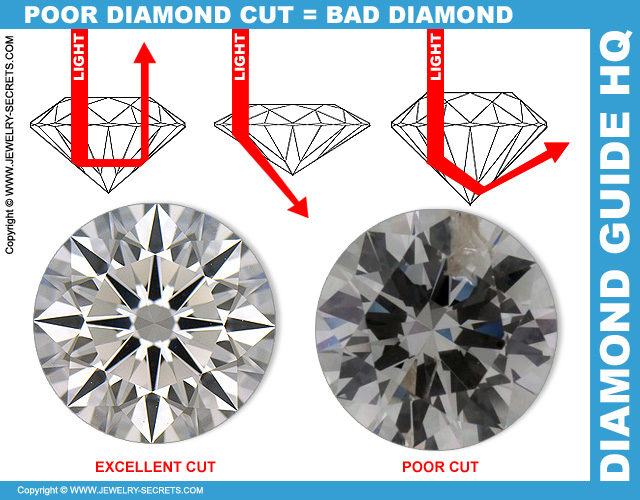
Cut is very important and needs to be studied.
I always recommend buying a GIA certified diamond with an “excellent” or “very good” cut grade. That way your diamond will sparkle and shine, and you can leave all the rest of the mathematical percentages to the experts. :)
Check out these excellent cut diamonds here at James Allen!
Cheers! :)


















Leave a comment